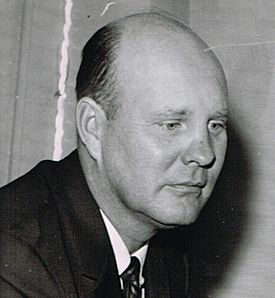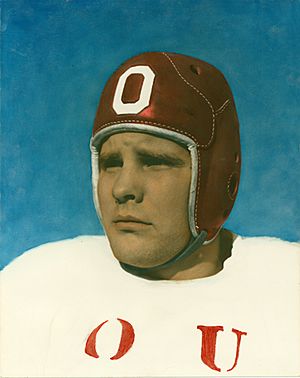Pop Ivy facts for kids

Pop Ivy in 1961
|
|
| Date of birth: | January 25, 1916 |
|---|---|
| Place of birth: | Skiatook, Oklahoma, U.S. |
| Date of death: | May 17, 2003 (aged 87) |
| Place of death: | Norman, Oklahoma, U.S. |
|
Career information
|
|
| Position(s): | End |
| Height: | 6 ft 3 in (1.91 m) |
| Weight: | 208 lb (94 kg) |
| College: | Oklahoma |
| NFL Draft: | 1940 / Round: 4 / Pick: 27 |
| Drafted by: | Pittsburgh Steelers |
|
Organizations
|
|
|
Career highlights and awards
|
|
Head coaching record Regular season WIFU: 50–14 (.781) Postseason WIFU: 11–4 (.733) Career record WIFU: 61–18 (.772)NFL: 15–31–2 AFL: 17–12 (.586) Overall: 93–61–2 (.603) |
|
|
Career stats
|
|
| Playing stats at NFL.com | |
| Coaching stats at Pro Football Reference | |
Lee Frank "Pop" Ivy (born January 25, 1916 – died May 17, 2003) was a famous football player and coach. He was special because he was the only person to be a head coach in three different major football leagues: the National Football League (NFL), the American Football League (AFL), and the Western Interprovincial Football Union.
Contents
Pop Ivy's College Football Days
Pop Ivy was born in Skiatook, Oklahoma. He got his nickname "Pop" because he started losing his hair early, even when he was a young player. He was part Native American.
He played college football for the University of Oklahoma from 1937 to 1939. He played both offense and defense for the Sooners. In 1939, he was named an All-American as an end.
Pop Ivy was a tough player and never missed a game due to injury. He showed his amazing skill in a 1939 game against the Texas Longhorns. He caught a pass that had been deflected and scored the winning touchdown late in the game.
Pop Ivy in the NFL
The Pittsburgh Steelers picked Pop Ivy in the 1940 NFL draft. However, he was soon traded to the Chicago Cardinals on October 17, 1940. He continued to play both offense and defense throughout his NFL career.
In 1942, he had his best season, catching 27 passes. This was the second-highest number of receptions in the league that year. His football career was paused for over two years while he served in World War II. He returned to play and helped the Chicago Cardinals win their only NFL championship in 1947. Pop Ivy was on the sidelines for the championship game because he had separated his shoulder a few weeks earlier.
Pop Ivy's Coaching Career
Coaching College Teams
In 1948, Pop Ivy started his coaching career. He became an assistant coach at his old college, the University of Oklahoma, working for coach Bud Wilkinson. He stayed there for six seasons. During this time, the team used a new strategy called the Split-T formation. This helped the 1950 team win the national championship.
Coaching in Canadian Football
On March 10, 1954, Pop Ivy moved north to become the head coach of the Edmonton Eskimos in the WIFU league. Over the next four years, his team had a great record of 50 wins and 14 losses. He led the Eskimos to win three Grey Cup championships in a row!
One of his most daring decisions was before the 1956 championship game. He moved their star quarterback, Jackie Parker, to play as a running back. He then put Canadian player Don Getty in as quarterback. This bold move worked, and they won the game 50–27 against the Montreal Alouettes.
Pop Ivy was also known for creating new strategies in Canadian football. He used ideas like having two fullbacks, quick snaps, and short kickoffs. He even came up with a formation called the "lonesome quarterback," which was later renamed the "shotgun" formation.
Coaching in the NFL
After a fantastic 14–2 season with the Eskimos in 1957, Pop Ivy's old team, the Cardinals, asked him to be their head coach. He accepted the job on January 9, 1958. His first two seasons with the Cardinals in Chicago were tough, with a record of 4 wins, 19 losses, and 1 tie.
After the 1959 NFL season, the Cardinals team moved to St. Louis. In 1960, the team improved to 6 wins, 5 losses, and 1 tie. However, in 1961, they fell to 5 wins and 7 losses. Pop Ivy resigned on December 6, 1961. He said he hadn't "accomplished the desired results."
Pop Ivy then signed with the Houston Oilers on March 5, 1962. The Oilers had won the AFL championship twice. In his first year with the Oilers, the team won their conference title with an 11–3 record. They played in the 1962 AFL Championship game, but lost a very close game 20–17 in double overtime to the Dallas Texans.
Even with this success, the team had a losing season in 1963, with 6 wins and 8 losses. Pop Ivy was surprised when he was fired on June 1, 1964, and replaced by Sammy Baugh, whom he had hired as an assistant.
Scouting and Assistant Coaching
After being fired, Pop Ivy quickly found a new job as a scout for the New York Giants. He then became an assistant coach for the Giants on February 3, 1965. After two seasons, the team had a very difficult year in 1966.
The Giants' owner, Wellington Mara, made a new rule that all coaches had to live in the New York/New Jersey area year-round. Pop Ivy and his wife, Inez, lived in Norman, Oklahoma, and did not want to move. So, Mara asked Ivy to stay on as a scout, which he agreed to do.
However, Pop Ivy returned to coaching as an assistant for three more seasons from 1971 to 1973. After the head coach was fired, Ivy went back to scouting. He continued as a scout for the New York Giants for another decade before retiring in 1984.
Images for kids



